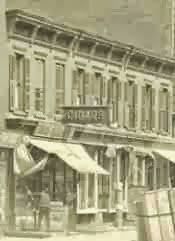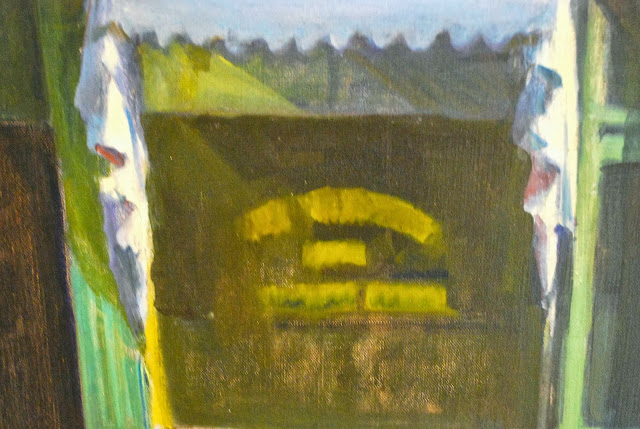 |
| "Early Sunday Morning" by American Artist Edward Hopper 1930 - Oil on Canvas 60" x 30" In the permanent collection of The Whitney Museum of Art, NYC. |
ART
"Early Sunday Morning"
A Painting by Edward Hopper
From time to time we enjoy looking closely at famous works of art, in order to notice all of the details. This week we have selected an iconic American painting by a wonderful American master from the first half of the 20th century, Edward Hopper (1882-1967). "Early Sunday Morning" is one of his most admired, most interesting and most beautiful paintings!
Gail Levin, an art historian, quotes Hopper on why he chose certain subjects to paint. "I do not exactly know," Hopper said, "unless it is that I believe them to be the best mediums for a synthesis of my inner experience." Lloyd Goodrich, a former director of the Whitney Museum of Art, wrote in 1970, "Hopper had no small talk. He was famous for his monumental silences; but like the spaces in his pictures, they were not empty." Hopper definitely preferred to leave all explanations to the viewer's imagination, best summed up in another of his quotes, "If you could say it, there'd be no reason to paint."
Hopper's paintings are loved by many and have been reproduced over and over again in art books and articles. He seems to capture something deeply-rooted in the modern American experience. An experience we still feel today as we try to create individual lives among the masses around us. His paintings are quiet, yet you hear the sounds or the wind or the lack of sound, surrounding his subjects. There is also tension in an ever-present sense of loneliness, but Hopper always finds the essential beauty inherent in his private spaces and environments.
In "Early Sunday Morning" we see his appreciation of a row of attached buildings at W. 15th Street and 7th Avenue in 1930's New York City (Manhattan) with shops on the street level and apartments above.
The first experience of the painting is the stillness that Sunday mornings always exude. We have all lived this moment on Sundays, when everyone else seems to be sleeping-in or taking-it-easy after a long work week and a late Saturday night. The peacefull world around us seems to be ours alone.
The second thing we notice is the palpable glow of the building in the long, warm rays of early morning sunlight and the shadows that light casts.
The structure is painted in red and green, complementary colors on the color wheel, which create a natural contrast and a vibrating effect in the eye.
The structure is painted in red and green, complementary colors on the color wheel, which create a natural contrast and a vibrating effect in the eye.
 |
| Complementary colors are directly across from each other on the color wheel. |
When you walk up to this painting, your eye first goes to the tilted and slightly off-center barber's pole, because the pure white paint against the dark window is the point with the most contrast and the white globe adds a highlight to the whole work. Along with the fireplug, the barber's pole also interrupts the repeated horizontal pattern created by the windows and both give the eye unique places to stop and focus.
Upon close inspection, the windows also have their own unique personalities, representing the individuals inside, and the storefronts represent each individual business.
Notice how each window is different, various window coverings with shades at different levels. Who lives in these apartments? Are the unseen people still asleep or are they reading the newspaper and drinking their morning cup of coffee? Are these people older, younger, male, female, couples or families?
Likewise each storefront is unique, with different business signage, different types of awnings, or no awning, one store is painted red and there are two hanging store signs balancing each side of the painting.
Through his genius, Hopper has painted the business names on the glass of each storefront window using his perfect scribble. From a distance, they look exactly like hand-lettered, gold leaf signs, but in reality there is no definition to his typography.
The words are actually one or two blurred strokes of yellow paint with an impressionistic wiggle of the brush on top. Up-close it looks wrong, as if the technique would not be effective, but it is. Hopper has made his signage anonymous, which adds to the timeless mystery of this work.
The store fronts also appear to be vacant, but at least one door is open. In some deserted, ghost towns a person may see a vacant building with the door open, but never in New York City. This store is most definitely occupied, with someone inside on this lazy Sunday morning.
The top green pediment of the building is quickly rendered with a few messy brush strokes.
Interestingly, none of the brushwork is precise or mechanical, in fact the whole painting seems to have been very quickly painted. The oil paint on the canvas is mostly applied in a thin layer. In many places the canvas itself, or its weave texture, shows through the scumbled paint.
The long deep shadows of this painting add to the vertical and horizontal essential geometry of his composition. Its simplicity is its beauty: quiet; glowing; enigmatic.

Edward Hopper's "Early Sunday Morning" is full of mystery and a painting very difficult to explain. Why is it so attractive to the viewer? The eerie stillness of this painting is best described by American philosopher Ralph Waldo Emerson who called such experiences "alienated majesty."
------------
The Whitney Museum of American Art is currently showing ‘Hopper Drawing’ an exhibition of Edward Hopper's preliminary sketches and other drawings, displayed near many of his paintings, including "Early Sunday Morning." The exhibition continues through October 6, 2013 - for more information go to whitney.org.
 |
| Old photo of actual building Hopper used as his inspiration for "Early Sunday Morning." |
 |
| The building was torn down soon after Hopper did his painting, "Early Sunday Morning." |
(Sources for this article, The Whitney Museum and archives from the New York Times.)
FOOD
"Japanese Salad Dressing"
One of the favorite parts of eating in a Japanese restaurant is the salad. The seaweed salad, octopus salad and chopped green salads. What they all have in common is the Japanese salad dressing.
Ingredients:
1/4 cup julienned carrot strips 1/2" long
1/4 cup diced shallots
1 knob of ginger root, grated
2 tablespoons of dried miso soup mix
1/4 cup rice vinegar
1/8 cup sweet rice wine, mirin
2 tablespoons toasted sesame oil
1/2 cup light vegetable oil (walnut)
1/4 teaspoon sea salt
1/4 teaspoon soy sauce
toasted sesame seeds on the side to top the salad
Directions:
Put all ingredients, except carrots, into a blender and mix well
Add carrots.
Put into a covered container and keep chilled.
Ladle over salads and top with toasted sesame seeds.
Until later,
Jack
ARTSnFOOD, is an online publication dedicated to "The Pursuit of Happiness through the Arts and Food." ™ All rights reserved for all content. Concept, Original Art, Original Text & "Original or Assigned Photography" are © Copyright 2013 Jack A. Atkinson under all International intellectual property and copyright laws. All photographs were taken and/or used with permission. Artworks © individual artists, fabricators, respective owners or assignees.

























